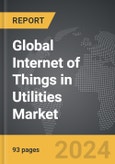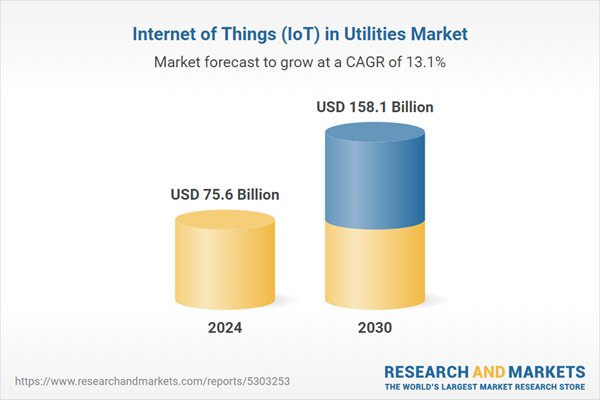The global market for Internet of Things (IoT) in Utilities was valued at US$75.6 Billion in 2024 and is projected to reach US$158.1 Billion by 2030, growing at a CAGR of 13.1% from 2024 to 2030. This comprehensive report provides an in-depth analysis of market trends, drivers, and forecasts, helping you make informed business decisions. The report includes the most recent global tariff developments and how they impact the Internet of Things (IoT) in Utilities market.
Segments: Component (Solutions, Platform, Services); Application (Electricity Grid Management, Water & Wastewater Management, Utility Gas Management).
Geographic Regions/Countries: World; United States; Canada; Japan; China; Europe (France; Germany; Italy; United Kingdom; and Rest of Europe); Asia-Pacific; Rest of World.
The analysts continuously track trade developments worldwide, drawing insights from leading global economists and over 200 industry and policy institutions, including think tanks, trade organizations, and national economic advisory bodies. This intelligence is integrated into forecasting models to provide timely, data-driven analysis of emerging risks and opportunities.
Global Internet of Things (IoT) in Utilities Market - Key Trends and Drivers Summarized
How Is the Internet of Things (IoT) Revolutionizing Utilities?
The Internet of Things (IoT) is revolutionizing the utilities sector by enabling smarter, more efficient management of energy, water, and gas resources. IoT devices such as smart meters, sensors, and connected grids allow utility companies to monitor resource consumption in real time, helping to balance supply and demand more effectively and reduce waste. By providing continuous data on energy usage, smart meters enable utilities to offer dynamic pricing models, encourage energy conservation, and detect anomalies such as leaks or faults in the system. IoT solutions also help utility companies improve operational efficiency through predictive maintenance of infrastructure, reducing downtime and extending the lifespan of critical assets.How Are Technological Advancements Driving IoT Adoption in Utilities?
Technological advancements in IoT sensors, AI-driven analytics, and edge computing are driving the widespread adoption of IoT in the utilities sector. IoT sensors are becoming more sophisticated and energy-efficient, enabling continuous monitoring of utility infrastructure such as power grids, water pipelines, and gas distribution networks. AI and machine learning algorithms analyze the vast amounts of data generated by IoT devices, offering predictive insights that help utility companies optimize grid performance, detect faults, and improve service reliability. Edge computing is enhancing IoT systems by allowing data to be processed closer to the source, reducing latency and enabling faster responses to critical events such as power outages or water leaks.How Do Market Segments Define the Growth of IoT in Utilities?
Components include hardware such as smart meters and sensors, software for data management and analytics, and services for system integration and maintenance. Key applications of IoT in utilities include energy management, grid monitoring, water management, and predictive maintenance, with smart metering being the largest segment due to the growing adoption of connected meters by utility companies. Geographically, North America and Europe are leading the market, driven by government regulations promoting smart grid development and energy efficiency, while emerging markets in Asia-Pacific are seeing rapid growth due to increasing investments in digital infrastructure and urbanization.What Factors Are Driving the Growth in the IoT in Utilities Market?
The growth in the IoT in utilities market is driven by several factors, including the increasing demand for energy efficiency, the growing adoption of smart grid technologies, and the need for real-time monitoring of critical infrastructure. As utilities seek to improve resource management and reduce operational costs, IoT solutions offer real-time insights into energy, water, and gas usage, helping to optimize supply and reduce waste. Technological innovations in AI, edge computing, and advanced sensor technology are further driving market growth by enabling predictive maintenance and improving the reliability of utility services. Additionally, regulatory mandates aimed at promoting energy conservation and sustainability are pushing utility companies to adopt IoT technologies to meet environmental goals and ensure long-term infrastructure resilience.Report Scope
The report analyzes the Internet of Things (IoT) in Utilities market, presented in terms of units. The analysis covers the key segments and geographic regions outlined below.Segments: Component (Solutions, Platform, Services); Application (Electricity Grid Management, Water & Wastewater Management, Utility Gas Management).
Geographic Regions/Countries: World; United States; Canada; Japan; China; Europe (France; Germany; Italy; United Kingdom; and Rest of Europe); Asia-Pacific; Rest of World.
Key Insights:
- Market Growth: Understand the significant growth trajectory of the Solutions segment, which is expected to reach US$94.1 Billion by 2030 with a CAGR of a 13.9%. The Platform segment is also set to grow at 10.9% CAGR over the analysis period.
- Regional Analysis: Gain insights into the U.S. market, valued at $20.9 Billion in 2024, and China, forecasted to grow at an impressive 12.4% CAGR to reach $24.2 Billion by 2030. Discover growth trends in other key regions, including Japan, Canada, Germany, and the Asia-Pacific.
Why You Should Buy This Report:
- Detailed Market Analysis: Access a thorough analysis of the Global Internet of Things (IoT) in Utilities Market, covering all major geographic regions and market segments.
- Competitive Insights: Get an overview of the competitive landscape, including the market presence of major players across different geographies.
- Future Trends and Drivers: Understand the key trends and drivers shaping the future of the Global Internet of Things (IoT) in Utilities Market.
- Actionable Insights: Benefit from actionable insights that can help you identify new revenue opportunities and make strategic business decisions.
Key Questions Answered:
- How is the Global Internet of Things (IoT) in Utilities Market expected to evolve by 2030?
- What are the main drivers and restraints affecting the market?
- Which market segments will grow the most over the forecast period?
- How will market shares for different regions and segments change by 2030?
- Who are the leading players in the market, and what are their prospects?
Report Features:
- Comprehensive Market Data: Independent analysis of annual sales and market forecasts in US$ Million from 2024 to 2030.
- In-Depth Regional Analysis: Detailed insights into key markets, including the U.S., China, Japan, Canada, Europe, Asia-Pacific, Latin America, Middle East, and Africa.
- Company Profiles: Coverage of players such as ABB, Aclara, Actility, Altair, Cisco and more.
- Complimentary Updates: Receive free report updates for one year to keep you informed of the latest market developments.
Some of the 37 companies featured in this Internet of Things (IoT) in Utilities market report include:
- ABB
- Aclara
- Actility
- Altair
- Cisco
- Energyworx
- General Electric
- HCL
- Honeywell
- Huawei
- IBM
- Itron
- Landis+Gyr
- Oracle
- Rayven
- Saviant Consulting
- Schneider Electric
- Siemens
- Telit
- Trilliant
- Trimble
- Verizon
- Vodafone
- Waviot
Tariff Impact Analysis: Key Insights for 2025
Global tariff negotiations across 180+ countries are reshaping supply chains, costs, and competitiveness. This report reflects the latest developments as of April 2025 and incorporates forward-looking insights into the market outlook.The analysts continuously track trade developments worldwide, drawing insights from leading global economists and over 200 industry and policy institutions, including think tanks, trade organizations, and national economic advisory bodies. This intelligence is integrated into forecasting models to provide timely, data-driven analysis of emerging risks and opportunities.
What’s Included in This Edition:
- Tariff-adjusted market forecasts by region and segment
- Analysis of cost and supply chain implications by sourcing and trade exposure
- Strategic insights into geographic shifts
Buyers receive a free July 2025 update with:
- Finalized tariff impacts and new trade agreement effects
- Updated projections reflecting global sourcing and cost shifts
- Expanded country-specific coverage across the industry
Table of Contents
I. METHODOLOGYII. EXECUTIVE SUMMARY2. FOCUS ON SELECT PLAYERSIII. MARKET ANALYSISIV. COMPETITION
1. MARKET OVERVIEW
3. MARKET TRENDS & DRIVERS
4. GLOBAL MARKET PERSPECTIVE
UNITED STATES
CANADA
JAPAN
CHINA
EUROPE
FRANCE
GERMANY
ITALY
UNITED KINGDOM
REST OF EUROPE
ASIA-PACIFIC
REST OF WORLD
Companies Mentioned (Partial List)
A selection of companies mentioned in this report includes, but is not limited to:
- ABB
- Aclara
- Actility
- Altair
- Cisco
- Energyworx
- General Electric
- HCL
- Honeywell
- Huawei
- IBM
- Itron
- Landis+Gyr
- Oracle
- Rayven
- Saviant Consulting
- Schneider Electric
- Siemens
- Telit
- Trilliant
- Trimble
- Verizon
- Vodafone
- Waviot
Table Information
| Report Attribute | Details |
|---|---|
| No. of Pages | 93 |
| Published | April 2025 |
| Forecast Period | 2024 - 2030 |
| Estimated Market Value ( USD | $ 75.6 Billion |
| Forecasted Market Value ( USD | $ 158.1 Billion |
| Compound Annual Growth Rate | 13.1% |
| Regions Covered | Global |









